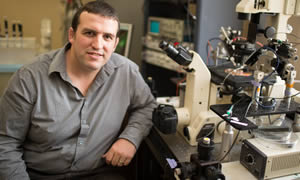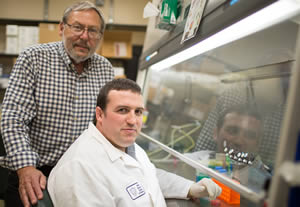

Promising Discoveries
Dr. Randy Stout: Mobilizing Our Understanding of Gap Junctions
Growing up on a farm in rural western Pennsylvania, Randy Stout enjoyed exploring the outdoors with his family. It was while hiking, camping and canoeing that his interest in natural sciences and discovery emerged.

Randy Stout, Ph.D.Now a postdoctoral researcher in the lab of Dr. David Spray, he recalled, “One of my most vivid childhood memories is of my father explaining to my brothers and me that the body was made up of microscopic building blocks. I was fascinated by this concept, and I knew then that I wanted to become a biologist.”
In 2004, after receiving his bachelor’s degree in biological sciences from Cornell University in Ithaca, NY, he returned to Pennsylvania and found work on oil and natural gas well sites and at a small lumber mill. Over the following year he had time to reflect on where his passion for biological discovery could flourish, and it became clear that academic research was the best way forward.
An Unexpected Journey
With the encouragement and support of his wife, Jessica, he returned to school in 2005, entering the Ph.D. program in cell, molecular and developmental biology at the University of California, Riverside.
He conducted his thesis research in the lab of Dr. Vladimir Parpura, where he focused on characterizing the role of the non-neuronal brain cells known as glia. Working with the roundworm C. elegans, Dr. Stout showed that glial cells influence neuronal activity and, consequently, worm behavior. His findings were published in journals including PLOS ONE, Cell Calcium, Frontiers in Cellular Neuroscience and Methods in Molecular Biology. The Parpura lab eventually relocated to the University of Alabama, Birmingham, where Dr. Stout received his doctoral degree in 2011.
Powerful Synergy

Dr. Stout with his mentor, Dr. David SprayBased on his interest in neuron-glia interaction, Dr. Stout then joined the lab of Dr. David Spray, professor of neuroscience and of medicine at Einstein, as a postdoctoral researcher. “Dr. Spray and I had worked together on a commentary published in Cell Science, about gap junctions in glial cells,” said Dr. Stout. “I knew that it would be exciting to work directly with him.”
For his initial postdoc project, Dr. Stout set out to characterize the composition and dynamics of the molecular complexes that form gap junctions. Gap junction channels allow neighboring cells to connect with each other and exchange small signaling and nutrient molecules. In this way, they are involved in a number of important brain functions, including memory, sleep and synchronized neuronal activity.
Using fluorescent protein-tagged gap junction proteins and advanced microscopy techniques, Dr. Stout discovered that some types of gap junction channels are very mobile within the molecular complexes they form while others are stably arranged. He also identified protein domains that control this gap junction channel mobility and established for the first time that the molecular complex of gap junction proteins and proteins to which they bind form a dynamic signaling complex. His current research is focused on testing how such newly discovered mobility of gap junction channels affect their role in signaling between brain cells through the exchange of small molecules. Many of these findings were published in the Journal of Biological Chemistry last year.
“Dr. Stout’s findings are important to the field,” noted Dr. Spray. “He has resolved controversies regarding the mobility of gap junction proteins.”
“I’ve received incredible support and guidance from Dr. Spray and his lab members, and from a broad range of Einstein faculty members both within and outside of our neuroscience department,” acknowledged Dr. Stout.
Einstein faculty members who have assisted or collaborated with him include Drs. Eliana Scemes, Erik Snapp, Ana-Maria Cuervo, Alberto Pereda, Ted Bargiello, Bridget Shafit-Zagardo, Michael V.L. Bennett, Vito Verselis and Mahalia Desruisseaux. He contributed to work by Dr. Cuervo, published in Nature Cell Biology in 2014, which revealed that gap junctions regulate degradation and recycling of cellular components in the cell process known as autophagy.
Earning Recognition in the Field
Dr. Stout’s research has received notable recognition at international meetings and generated strong interest among other research groups. He has recently initiated exciting collaborations with Drs. Peng Guo and Yinghao Wu at Einstein, Dr. Antonio Frigeri at University of Bari, in Italy, and Dr. John Rash at the University of Colorado.
“Dr. Stout is a triple threat,” said Dr. Spray. “With his accomplishments in the fields of glial biology and gap junctions, and his expertise in cutting-edge microscopy techniques, he plays a key role in many of my longstanding collaborations.”
“My goal is to further explore glia function and use new approaches to answer additional questions raised by my recent work on gap junctions,” noted Dr. Stout. “I plan to achieve this through cutting-edge and novel uses of electrophysiology, super-resolution microscopy, computational modeling and optogenetics. For me, the most exciting part is discovery.”
Posted on: Wednesday, April 6, 2016

Tablet Blog